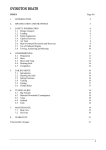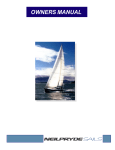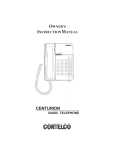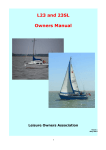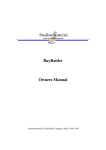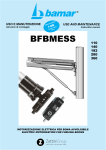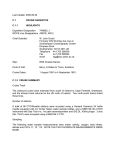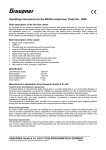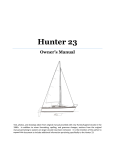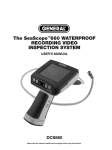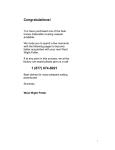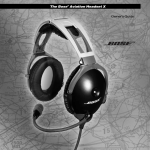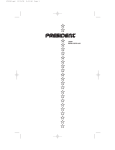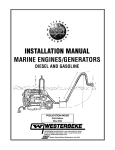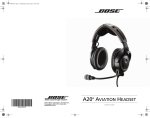Download WEST WIGHT POTTER 15 User`s guide
Transcript
WEST WIGHT POTTER 15 USER'S GUIDE International Marine 904 West Hyde Park Boulevard Inglewood, CA 90302-8803 Congratulations! You have purchased one of the best known trailerable cruising vessels available. We invite you to spend a few moments in the following pages to become better acquainted with your new West Wight Potter and at any point, if we can assist, do give us a call— 1-800-433-4080. Best wishes for many pleasant sailing adventures! Sincerely, West Wight Potter 2 Table of Contents Getting Your New Boat Ready .................................... 4 Safety Equipment ......................................................... 5 Anchors......................................................................... 5 Trailering Made Easy ................................................... 6 Launching (Getting the Potter Wet) ............................. 7 Hoisting the Sails.......................................................... 8 Jib and Jib Sheets Set-up ............................................ 10 The Two Rules of How to Sail................................... 11 Sailing Away—the Fun Part....................................... 11 Balance ....................................................................... 13 Mooring ...................................................................... 13 Motoring (Forget the Sails, Full Speed Ahead) ......... 14 Heading Home with Your Boat in Tow ..................... 15 Your Boat's Optional Equipment ............................... 15 Tips ............................................................................. 20 Warranty ..................................................................... 22 Basic Sailing Terms.................................................... 23 Glossary ...................................................................... 24 3 Getting Your New Boat Ready When your new Potter first arrives (after a quick hose-down with a sponge and soapy detergent), climb aboard and get a feel for your new boat's cockpit and cabin. Before your first launch, several items may need to be assembled on a onetime-only basis. Leave these items permanently connected for convenience. First, connect the side stays (wires) from the mast to the connectors on the sides of the boat. The side stays are on either side of the mast, about ¼ from the top. The pins on the adjusters on either side of the deck are set for the proper location of connection (see Figure 1). Make these initial connections with the mast in its lowered, horizontal position. Note that two of the three mast stays are now connected, and that when you push the mast into place for sailing, only the remaining forestay (front wire) will need to be connected. Next, push the batten sticks into the pockets provided in the mainsail. The battens are of various lengths; identify which length goes where by holding them up next to the sail pockets. The pockets have a locking flap to hold the battens secure. The large upper batten has a small cord—tie it to the grommet hole on the sail to prevent it falling out in high winds. Now the sail can be connected to the boom. The tack grommet hole on the lower front of the sail is connected by the twist release pin in the front of the boom. The clew grommet hole on the back lower portion of the sail is tied and led through the block at the back of the boom and then cleated on portside (see Figure 2). Finally, the rudder may be mounted on the back of the boat. 4 Safety Equipment Ensure that all safety equipment has been obtained and is on board. Provide one US Coast Guard approved personal flotation vest for each person on board, plus at least one throwtype seat cushion for the cockpit. Many types of flotation vests are available and it is important that each person sailing has one that is correctly sized—especially smaller children, on whom adult vests would be useless. Check your local boat store for various available vests, such as the thinner types more easily worn at all times. Check the attachment buckles on the vests for ease of operation. For small children, make sure the attachment buckles cannot be easily released. Always encourage everyone to wear their flotation vests. In a situation where an individual is not wearing a vest, make sure that a vest is easily obtainable, unbuckled, fully adjusted for the individual, and is in plain view for quick use. If all vests are located in one location, tag each vest for easy identification. Always have a throw cushion within an arm's reach. CAUTION: Use of personal flotation vests greatly increases comfort and safely during sailing. Anchors You may wish to obtain a small anchor. Different types of anchors are available for different sea-bed conditions. Visit your local boat store to find their recommendations for your area. The store will usually have a chart matching a particular anchor model to the size of your boat. Get the smallest anchor recommended for your boat. A smaller anchor will keep weight down and make actual use easier. For similar reasons, do not use chains between the anchor and anchor rope, which (in addition to extra weight, cost, and inconvenience) can bang up and scrape your boat's paint. If extra weight is needed, tie extra weight (5 to 10 pounds) back from the anchor on the anchor line—though extra weight should not be more than half on the anchor's weight—which will simulate a chain. Mount the anchor on your front bow rail or front boat deck with the opposite end of the anchor line through the air vent to the anchor attachment plate provided in the front anchor line compartment (reached from inside the cabin). Now your anchor will always be ready to use. When using your anchor, you need enough line so that the angle of the line from the boat to the sea is about 45° or more. The rule of thumb, or "scope", is 5 to 1: the length of anchor line should be five times the depth below the boat. 5 Trailering Made Easy Your Potter can be a joy to trailer, with the light towing weight and low trailering height. The high-speed tires and wheels on your trailer are supplied with grease wheel fittings (bearing buddies) to ensure ultimate serviceability when backing your trailer into the water. Using a hand grease gun with an automobile-type fitting (available from your hardware or automotive store), apply grease through the fitting in the center of the wheel until the visible diaphragm moves outward slightly. Grease fittings twice yearly or more with frequent use. NOTE: Adding grease frequently to the wheel fittings will avoid corrosive damage to wheel bearings from water contact. When trailering at highway speeds, use the tie-down rope or optional straps provided with your Potter. The tie-down should be connected to both sides of the trailer frame while going across the cockpit of your Potter. Your Potter nestles firmly on its trailer, and you may find the tie-down not necessary for slower off-street use and when no side winds prevail which might sway the Potter. CAUTION: Use of the tie-down rope or strap is important to prevent the separate movement of the boat and trailer caused by highway speeds, crosswinds, tight cornering, bumpy roads, emergency braking, or suction from passing vehicles. Before trailering, check how tightly your car may be turned without the trailer tongue contacting any part of your bumper. If you are new to backing a trailer, go to a shopping center parking lot during off-hours and practice backing before your first launching. The most important points to check before trailering are as follows. • • • • • • • • • • • Mast in down position and secured to boat Mast wires tucked in cabin door or tied securely Rudder tiller arm secured to prevent movement Rudder blade in up position or placed in cabin All equipment and accessories on board Tongue hitch latched firmly to car towing ball Tie-down rope firmly attached Trailer safety chains connected to car Trailer winch rope connected and tightened to boat towing eye Electrical plug connected to trailer for proper lighting Right- and left-hand rearview mirrors checked for proper position If you do not yet have a hitch for your car, hitches are available for most cars from your local auto parts supplier. Also, most truck hire agencies fit hitches. The electrical plug connector for your car is provided with your boat. The trailer uses the industry-standard 4prong flat plug without grounding (grounding is achieved through the metal-to-metal contact of the hitch connection). 6 Launching (Getting the Potter Wet) Launching your new Potter in the water is easy compared to other similarly sized boats, but for the first several launchings you will want to take extra time to ensure everything is correct. Assuming you have prepared your Potter as discussed in the Getting Ready section, you will be generally concerned with pushing the mast up into place, backing the trailer into the water, raising the sails, and—the exciting part—sailing away! Usually the mast is raised while the boat is on the trailer, right before backing into the water. Before raising the mast, double-check that the side stay is connected to the boat, so that when the mast is pushed up only the front mast stay need then be connected. WARNING: Check very carefully that no overhead obstructions are present which would interfere with the movement of raising the mast, especially overhead wires, which may produce undesired sparks or electrical current. After checking that no overhead obstructions are present, and after releasing all mast tietowns (but not the side stays), position yourself: Stand on top of the keel-well slot inside the cabin, with the cabin hatch fully open. This is a firm position, with the hatch opening sides giving lateral support. Grab the mast, check that all mast wires fall freely without kinks, shoulder the mast, and slip back until you can place the base of the mast on the cabin-top mast step. With the base seated at the back of the mast step, push the mast into its fully vertical position. At this point, have an assistant attach the free front mast wire to the front hole of the deck-plate connector. If an assistant is not available, it is easy to walk forward while holding slight forward pressure to the mast front wire, and install. Or, prior to listing mast, temporarily connect jib halyard to bow plate, and cleat halyard until the front stay can be connected when mast is positioned. Nothing else needs to be done for the mast. There are several ways the mast might be conveniently raised, although your first few tries may be awkward until you get familiar with the procedure. You may wish to stand in position and practice several "trial runs" to determine the most comfortable position for you. Now prepare two handy dock lines, 6–10' long, and tie them to the front and back cleats of the boat. Tie a knot in the unattached end so it won't slip out of your hand while holding. Lay these lines on the deck with the noted end ready to grab as needed. Next, remove the tie-downs from the boat and unplug the electrical connectors from the car. CAUTION: Disconnecting the trailer electrical plug from the car before launching will ensure no electrical short will occur, should water contact any part of the trailer electrical system. Back the trailer to the water's edge at the end of the launch ramp, set all brakes, and remove any gear from the car which should be in the boat. 7 WARNING: Leaving the trailer winch hook connected while backing down your launch ramp will keep the boat from accidentally sliding backward off the trailer, should the trailer bolsters or boat bottom be slippery, or should the launch ramp be excessively steep. Now, with your assistant walking beside the trailer holding the end of the front dock line, continue backing your trailer until the trailer wheels are under water—usually about the point where the water is just under the rear car bumper—at which time, hit your car brakes sharply, and the boat will slide/float smartly off the trailer, retained by your assistant holding the dock line. Should an assistant not be available, tie the dock line to the trailer or to a nearby dock before backing into the water. Once the boat slides/floats from the trailer, pull the car and empty trailer forward and head to your parking area (removing the dock line if attached to the trailer). With your boat moored at water's edge, tied to your dock, or anchored close to shore, you are nearly ready to raise your sails and sail away! Hoisting the Sails You have now reached the most exciting point of your day: raising your sails and sailing away. First, lower your keel to ensure stability before raising your sails. Loosen the keel line, located on the right side of the keel box between the cabin cushions, while holding firmly. Then, feed the line out slowly, still holding firmly, until the visible arm from the keel rotates all the way to the back on the keel-box slot. Keep in mind that there is a slight pulling force on the keel from the weight of the keel itself, and you must hold firmly to this line until the keel arm is fully back. WARNING: Keep your hands and fingers completely away from the keel and keel housing when it is being lowered or raised. Also, do not let the keel fall freely, as the rotating arm may bump the keel box excessively during lowering. Once the keel is down and the keel line loose, take the keel line connected to the end of the keel arm, and secure it to the cleat on the right side of the keel box near the arm. This locks the keel down for safety in heavier seas. (Of course, remember to release this keel line when you sail up on the beach or get into very shallow water.) NOTE: Locking the keel arm line to the keel cleat will increase the stability of the boat during heavy seas and high winds. Your keel has a slot, located on the front edge of the keel, which slides over a ⅜" keel pin. This arrangement allows the keel to be removed for service. 8 Mainsail With your boat pointed into the wind if possible, place the 3" sliding bar of the flexible fitting on the front of the boom into the mast-slot opening, located close to the mast base. Let the sliding bar drop down below the opening, then tie or shackle the loose end of the line from the right side of the mast to the top of the sail. Feed the top end of the mainsail in the mast-slot opening while pulling the sail all the way to the top of the mast, securing the remaining end of the line to the cleat on the starboard (right) side of the mast. WARNING: Always keep clear of the boom, as the sail may blow the boom about overhead. Mainsheet Set-up To secure the boom's movement, take the mainsheet (main sail-control line) provided on the back of the boom, and lead it (1) down through the double block on the rope at the back of the boat, (2) up to the closest block on the boom, (3) forward to the next block on the boom, and (4) down to the swivel-cam cleat in front of the door (see Figure 3). Pulling the main sheet through the cam cleat slightly will stop any sway of the boom. NOTE: The main sheet may be left permanently connected for convenience. 9 Jib and Jib Sheets Set-up Next, raise the jib (front sail) by connecting the clips provided on the sail to the forestay, the wire running from the top of the mast to the bow (front of the boat). With the sail connected to the forestay, connect the jib halyard to the free end of the line on the left (port) side of the mast to the top of the sail, and pull tight. The other end of the jib halyard is then tied to the cleat on the left side of the mast. To complete, take the jib sheet (the front-sail-control line provided) and tie the midpoint of this line to the clew, the remaining hole on the back of the jib, such that two lines then lead from this hole, one to each side. Each line is led outside the wire stays to the cam cleats located on either side of the cockpit near the cabin door (see Figure 4). Most of the preceding guidelines will be quickly mastered and, after you have launched and set up for sailing several times, little thought will be needed to get your boat ready. 10 The Two Rules of How to Sail Whether you are a first-time sailor or a seasoned veteran with years at sea, your sailing skills will mostly concern the two rules of how to sail. The two rules apply to all sailing conditions and have no exceptions. Rule 1: Point the boat in any direction you wish to go, except directly into the wind. (See Figure 5.) Rule 2: Have the sail-control lines as loose as possible without the sails wriggling and flapping in the wind. (See Figure 6.) And away you go! Sailing Away—the Fun Part If you are moored dockside (preferably pointing into the wind, for ease of raising your sails) push the front of your boat away from the dock to meet Rule 1 (point the boat any direction except directly into the wind). If at anchor, the wind will usually blow your boat to point into the wind. If you are launching from the beach, push off at an angle if the wind is blowing directly onto the beach. 11 CAUTION: At this time, double-check that your keel is in its full down position. With the boat pointed as appropriate, pull in the sheets until both the jib and mainsail stop flapping. You are now at full speed, with perfect sail adjustment; however, constant attention to this adjustment is important. Any time your boat direction changes, the wind changes, people move to different positions on the boat, or you are unsure what is happening, go through the two rules—and always repeat the rules in sequence: Rule 1, then Rule 2. Let's try the rules on some maneuvers. Assuming you are still sailing straight ahead from your starting position, how do you change direction? (1) First, steer the boat to any direction other than into the wind (if it's OK to make a turn through the direction of the wind). When you are pointed in the direction you wish— (2) —let the sheets out as far as possible without the sails flapping. Remember, you have two sets of sail-control lines: the pair of jib sheets coming from the jib leading to the cam cleats on either side of the boat, and the single mainsheet from the boom on the mainsail leading to the center-mounted cam cleat. You will always know which jib sheet to use (left or right) as it is always the line on the same side of the boat as the sail blows toward. The jib sheets will be the ones you are continually adjusting (to keep sails as loose as possible under Rule 2), as the mainsheet often needs only slight adjustment. In fact, many sailors find a "middle" position for the mainsheet, and make no adjustments to it at all under most sailing conditions. When you are planning a turning maneuver, let the jib sheets completely loose before starting your turn (Rule 1 so you can concentrate on making your turn. Once lined up in the direction you wish, pull the opposite jib sheet in until the jib stops flapping (Rule 2). Sometimes, when making turns, the pressure of the wind on the sail is at such an angle so as to put extra pressure on the jib sheet, increasing the force necessary to easily release the jib sheet from its respective cam cleat, which pre-loosening the jib sheets helps prevent. WARNING: To ensure the boat is not forced excessively sideways in the wind, always make sure the sheets are as loose as possible. Special care should be taken when you are turning or are sailing very close to the direction from which the wind is coming, because a slight, inadvertent change of boat direction could mean the sails become not as loose as possible without flapping. For ultimate comfort, have all sheets as loose as possible before starting any maneuver. Breaking either of the two rules of how to sail can stop your boat from going forward. This is useful when you want to stop. If you carefully sail your boat until directly pointed into the wind, the wind will have no effect on the sails, the sails will flap and wriggle with the sheets go as loose as possible with sails flapping and with the wind having no effect on the flapping sails—regardless of the direction of the sail (except if the boat is headed downwind; in that case, you will need to steer upwind before the sails will flap and wriggle). 12 Your boat will be stable and upright if you follow Rule 2 and have the sheets as loose as possible without the sails flapping. In stormy or heavy wind conditions, hold the sheets lightly in your hands, so that any unusual wind change can be countered by releasing the sheets quickly from their respective cam cleats. Balance Although the two rules of how to sail will take care of most situations, you should also practice good boat balance. That is, have the majority of your passengers seated on the upwind side of the boat (the side from which the wind is blowing) to keep the boat more level, for greater sail efficiency, and for comfort. As the boat operator, be seated on the upwind side of the boat for a clearer view. Of greatest importance is shifting to the other side of the boat at the same time you are turning through the direction from which the wind is blowing. A little practice leads to comfort. In very light winds, no shifting of sides is necessary. Mooring When you are ready to come in, sail back to your dock or mooring area. At the desired spot, let your sheets completely out (loose) and point your boat into the wind. You will come to a stop momentarily; then you can either hop out if at shore's edge, drop anchor, or throw a line around your dock tie-up clear. If you are sailing to a dock, make a wide approaching pattern so you will reach the dock at just the point you turn into the wind, loosen control lines, and come to a stop. (See Figure 7.) With practice, you'll be able to stop with enough time to calmly step out of your boat onto the deck to complete tying your dock lines. 13 Motoring (Forget the Sails, Full Speed Ahead) With the Potter's flatter hard chine hull configuration, excellent motoring performance may be obtained from a smaller, less expensive motor than is necessary for other boats. For the Potter 15, a 2.5–3.5 HP motor is typical. If you have not yet purchased your motor, make sure the motor you get is as small as possible, which is important for several reasons: • • • • lower cost lighter weight for easier handling less fuel used has integral fuel tanks to eliminate lines and bulky containers in cockpit With your motor tightly clamped to the motor mount and a securely fastened chain or rope fitted for additional security, you are almost ready to motor away. The most important factors to remember before starting your motor: 1) Lower the available optional kick-up rudder blade, if applicable. 2) Fill tank with proper gas/oil mixture. 3) Open fuel tank cap air vent. 4) Open fuel ON-OFF valve on side of motor. 5) Shift gear to neutral (if provided). 6) Choke and set correct throttle for starting. (If choke and throttle setting are not set correctly before pulling the starting rope, the motor may be "flooded.") 7) Pull the starting rope with a strong, straight-back force while simultaneously holding firmly to the boat. For steering, leave the motor pointed directly ahead, steering with the boat's rudder. Your motor has a friction screw that may be tightened to prevent the motor from turning inadvertently while steering. When motoring, you must yield to other boats under sail alone, which have the right of way. Keep on hand a closed auxiliary emergency can with extra fuel for the occasional unexpectedly empty tank. For best cruising performance, run your motor at about ½ to ¾ throttle, when possible. There are a host of interesting ways to use your motor to make sailing more enjoyable. For example, a distant island or destination might necessitate an early morning start. Lacking wind upon starting out, you could motor; then, with the first breezes, switch to sail. The motor will also prove to be useful, for example, for exploring narrow inlets and channels; getting into a busy, congested dock area; and for slow speed while fishing. The motor adds an additional dimension to your enjoyment of your Potter. 14 Should you have specific questions regarding motors not supplied with your Potter, we will be pleased to advise you to ensure a proper boat/motor match. Heading Home with Your Boat in Tow Before getting your boat out of the water and onto its trailer, take the sails down and raise the keel (the reverse of the procedure for lowering the keel). With the trailer as far back into the water as possible and with your car's rear bumper at the water's edge, float your boat onto the trailer, pulling with the front dock line connected to the boat. With a little practice, this will become easy. With experience, you will be able to nudge your boat slightly while on dock, and, while guiding the front and back deck lines, be able to lead the boat directly onto its trailer. Without a dock, stand on the trailer tongue to lead your boat. When the boat "catches" the trailer support cushions, connect the trailer winch hook to the boat's trailer eye and crank firmly until the front of the boat touches the upright support on the trailer. WARNING: Make sure your keel is in the full up position so as not to interfere with retrieving your boat onto its trailer. Driving your boat and trailer directly up the ramp, proceed to the closest level location to lower your mast (reverse of raising) and reinstall the trailer tie-down ropes or straps for highway trailering. Double-check that your mast and all loose lines are secured such that nothing dangles over the side that might interfere with trailering. Remember to reconnect the trailer electrical plug. As a rule of thumb, never disconnect anything unless it is absolutely necessary in order to get your boat home. Whatever remains connected means a fast launch next time. Your main sail may easily be left connected to the boom, with all battens installed, and still fit inside the cabin. Also, all sail lines have extra length, and can be connected to the mast and led under the cabin door. It's a good practice not to disconnect the mast stays (wires) other than the single front wire to let the mast down. Your Boat's Optional Equipment We have now covered all aspects of operating your standard Potter. Although a standard Potter includes everything to sail and trailer away, additional items are available as optional extras. Please note: each option that may be installed after manufacturing is marked with an asterisk (*). Unmarked options must be installed during manufacturing if at all. 15 Reefing Points Reefing points include five equally spaced metal grommet holes and associated reinforcements, located in a row about ⅓ the way up from the bottom of your mainsail. In heavier winds, take five short lengths of rope (3'–4' each), and, threading through each grommet hole, pull down and tie that portion of the lower sail to the boom (see Figure 8a). Jiffy Reefing System The Jiffy Reefing System includes the reefing points, plus lines that go up through the front and rear reefing grommet holes and back to a convenient clearing area. With this system installed, you can quickly reef your sail. However, the Jiffy Reefing System does require extra time when raising your sails, and is recommended over the manual reefing points only if you are considering long range cruising or frequent sailing in stormy weather (see Figure 8b). 16 Genoa Sail* This is the largest front sail and is used in light air conditions and for greater speed. Raise this sail just as you would your standard jib. Genoa Tracks and Blocks Included in this option are blocks which slide in position front to back along stainless steel tracks mounted on both outer sides of your Potter. They are used with the genoa sail to position the angle at which the jib sheet intersects the sail. Feed the jib sheet from the sail to the moveable block, then to your front sail cam cleats. The objective of this system is to have the sheet angle to the sail such that if an imaginary line were projected straight from the sheet over the sail, the sail area would be bisected exactly. You will note that when your sail is operating out and away from the boat, the adjustable block is toward the rear of the track. When the sail is operating close to the boat, the adjustable block is toward the front of the track. This option allows precise adjustment for the experienced sailor, but is also popular with all sailors for fun in experimenting with different positions for the fastest possible speed. (see Figure 9.) Genoa Whisker Pole* An adjustable aluminum pole, the option also includes a special quick release fitting 12" up from the base of the mast. The pole is best used when sailing downwind, as the pole holds the sail in its straight-out position, for greater speed and control. The pole also allows the genoa sail to simulate much of the effect achieved with the optional spinnaker sail. 17 Spinnaker Sail* This large, balloon-type sail is used mainly for sailing downwind, and is characterized by its billowing shape pushing out in front of the boat. All Potter spinnakers are multi-colored and easily recognizable. The spinnaker raises just like the standard front sails, but on its separate mast-hoisting line, and with the sail control lines leading back to the cleats at the rear of the boat. No special adjustment is needed for downwind sailing; just ensure the sail is full from the wind. The spinnaker sail, although used less frequently in sailing, is certainly one of the most beautiful sails you can have for your Potter. This lightweight sail is also frequently seen in racing events. (See Figure 10.) Spinnaker Hardware and Pole* Although not absolutely necessary, this option greatly increases the effectiveness of your spinnaker. Included in the option are special blocks on each side at the back of the boat, a special halyard for raising the spinnaker on the mast, and a properly sized quick-release spinnaker pole which connects between one end of the spinnaker and the mast. A line from the deck up to the center of the pole holds the pole in a level position. (See Figure 10.) Although a little more attention and skill might be needed to operate the spinnaker and accessories, once mastered, you will have the same skills used with the largest spinnakers on the fastest offshore cruising yachts. 18 Boom Vang* The boom vang consists of an adjustable line with a reduction-type locking block between the base of the mast and a point angling upward to approximately one-third of the way back on the boom. Designed to place a downward force on the boom, and correspondingly flattening the mainsail, the boom vang is especially useful to ensure a flatter sail area in downwind sailing conditions. Although you will spend a little extra time in connecting the boom vang fittings before sailing, the boom vang remains one of the most requested sailing options for the Potter. (See Figure 11.) NOTE: Remember to let out the sheet on the boom vang before raising the mainsail. Mast Topping Lift* A light line which loops to the top of the mast and back to a tie-off cleat, this option is useful as it holds the boom in place when the sails are down. It can also be useful for gaining access to the top of the mast, e.g. for raising your yacht club burgee, racing flags, and pennants. Cockpit Sunshade* A flat awning with battens, the sunshade covers the cockpit area while attached to the boom. An excellent shade protector at dockside, the sunshade is not used while sailing. Of special importance, the cockpit sunshade is more useable than cockpit tents and enclosures, which can blow the boat about unnecessarily in heavy winds. Board Steps These steps are securely fitted to the transom of the boat. They are excellent for the swimmer and occasional snorkeler, and also a useful item for getting into the cockpit while the boat is on the trailer. 19 Canvas Items* We also have a wide range of canvas items available for the Potters 15 and 19. These include a complete boat cover, sail cover, bimini top, and dodger. All are made with Sunbrella material, and all are specifically designed for the Potter boats. Tips As you use your Potter, you will find special ways to save time with launching and retrieving while perfecting your skills in sailing. Several areas might be considered. Tips on becoming a sailor Even with the Potter's easy-to-handle characteristics, you may find it interesting to enroll in a local US Power Squadron or US Coast Guard boating course. These courses will give you a chance to meet other boaters in your area, and will generate useful ideas for sailing your new Potter. When possible, take these courses before getting your Potter. Both of these nonprofit organizations may be located through the white pages of your local telephone directory. Never disconnect anything you do not have to disconnect in getting your boat home after a sail. This tip may be used as a test before removing or disconnecting any item on your boat after use. In setting out, find the right sequence for putting up the mast and sails, lowering the keel, starting the motor, and sailing away. Although the usual sequence has been discussed in this User's Guide, your conditions may dictate a different pattern. When you are first beginning to sail, or when you plan to practice new sailing techniques, take along as few passengers as possible. The Potter is easily sailed by one person; a large number of passengers, all trying to "help," may make your sail more difficult. It may be helpful to have younger members of your sailing group visit up front on the deck, to increase cockpit operating space. Trailer tips When trailering, take along a spare tire or at least one of the "instant" aerosol tire inflators. Trailer tires should be fully inflated per the pressure range imprinted on the sidewall of your tires. Under-inflated tires can overheat and have excessive wear. Regularly check the hitch connector and safety chains during extended trips. It's all too easy to fill the Potter's cabin with many different items while under tow. Remember that whatever you "dump" in there for the journey must also be taken out and reorganized before you can comfortably set sail. 20 Maintenance tips When cleaning your boat, do not wax as this may provide a surface which will collect additional dust and dirt. Use regular dishwashing detergent or soft compound on the more difficult spots. For the rub rail, use soft scrub. Once or twice a year, use a marine silicone cleaner/sealer to seal the fiberglass, and treat the outside wood with teak oil to keep it looking good as new. A final note, if you have not yet purchased your Potter or are adding options to your boat: Your best value is the standard boat, with just those additions you know you want now, or that cannot be retrofitted later. The standard boat provides the same exhilarating sailing experience as the heavily option-loaded boat. 21 Warranty WARRANTY The following warranty applies to all new boats: LIMITED WARRANTY West Wight Potter 15 & 19 All fibreglass parts (Hull, Deck, and Liner) are guaranteed against any defects in workmanship for a period of 3 (three) years from the original date of purchase, to the original owner listed by the manufacturer/ factory. All other parts and accessories purchased and installed by the manufacturer/factory as original equipment are covered by the original manufacturer's guarantee, not to exceed one year. Any fibreglass or defective parts bust be returned FOB to factory for either replacement or repair at factory's discretion. Ordinary use, neglect, misuse or abuse are not covered by this warranty. 904 West Hyde Park Blvd., Inglewood, CA 90302 INTERNATIONAL MARINE 22 Basic Sailing Terms MAST Parts of the Boat fore: toward the front aft: toward the back bow: "fore" end stern: "aft" end port: left side starboard: right side FORE AFT JIB DECK COCKPIT CABIN cabin: part you can get inside of cockpit: where you control the boat from deck: flat surface on top in front mainsail: the big sail jib: the smaller sail in front BATTENS MAINSAIL BOOM TILLER STERN BOW mast: vertical pole boom: main horizontal pole battens: sticks in pockets on a sail that stiffen it RUDDER KEEL Parts of the Boat keel: retractable device used to stabilize the boat in the water rudder: movable device used to steer the boat while motoring tiller: what you move the rudder with Parts of the Sail Sail Edges foot: bottom edge (closest to boom) luff: inner edge (closest to mast) leech: outer / "free" edge (longest) Sail Corners head: top corner clew: "free" corner at bottom outside (acute angle) tack: pivoting corner at bottom inside (90° angle) 23 Glossary aft: rear of the boat battens: thin sticks placed in pockets on a sail to reduce unwanted sail movement belay: [verb] make fast by wrapping around a cleat bitter end: the end of a rope that is tied off block: a pulley or combination of pulleys used to direct lines boom: a horizontal pole, attached to the mast, that extends under the foot of a sail and to which the sail connects; a kind of spar. Also called mast boom boom vang: an adjustable line between the base of the mast and a point angling upward to about one-third of the way back on the boom; it flattens the mainsail by pulling / holding it down cam cleat: device with rotating cams that automatically locks tight the connecting line cleat: device to tie-on lines clew: outer, moveable bottom point (corner) of a sail. Mainsails, jibs, and genoas have one clew each; spinnakers may have one or two each cockpit: open seating area in aft of boat deck: walking area on top of boat downhaul: a line that applies downward force on a spar or sail downwind: [adjective] wind is blowing from the rear of the boat fairlead: a device used to keep a loose end of line from sliding around the deck fast: [adjective] fixed; made to not move foot: bottom edge of a sail fore: front of the boat genoa: a headsail, best for heavy wind; bigger than a jib, so that it overlaps the mast and part of the mainsail—optional Potter equipment, alternative to a jib genoa tracks: blocks which slide in position front to back along stainless steel tracks mounted on both outer sides of the boat, used with the genoa sail to position the angle at which the jib sheet intersects the sail genoa whisker pole: a type of spar; a lightweight spinnaker pole for use with a genoa sail guy: a line that controls a spar 24 halyard: a line used to raise (hoist; haul up) a sail. (Compare to sheet and vang.) head: top point (corner) of a sail. Alternately, a toilet located on a boat; however, the Potter doesn't have room for this kind of a head. headsail: the sail in front of the mast; sometimes also called foresail. The headsail that comes standard with your Potter is the jib. Optional alternate headsails include the spinnaker or the genoa. jib: a headsail, best for moderate wind, that doesn't overlap the mast—the foresail on a standard Potter. Large sailing ships may have more than one jib. Jibs, spinnakers, and genoas are all types of headsails (also called foresails) that may be used on your Potter. A jib is also a kind of staysail. jib sheet: one of the two sheets that control the jib, used to move the free corner, attached to the jib's clew. jibe: [verb] to turn the stern through the wind, so that the direction of the wind changes from one side of the boat to the other; the opposite of the verb tack keel: the part that sticks out of the bottom of the boat lengthwise (fore to aft) so as to keep it upright in the water and help make it steerable keel trunk: compartment in center of cabin into which the keel retracts (for when the boat is being trailered or beached or is in very shallow water) leech: trailing edge of a sail line: a rope used in rigging. See also guy, halyard, jib sheet, sail-control lines, sheet, vang luff: leading edge of a sail mainsail: the sail in back of the mast; the primary sail mainsheet: the sheet that controls the mainsail, running along the boom, attached to the mainsheet's clew mast: long vertical aluminum pole, rising from the top of the boat, stabilized by wires (stays); constructed in a teardrop-shaped cross section, the rounded side is towards the fore and the pointed side to the aft. A Potter has only one mast; large sailing vessels may have more. The middle or single mast is the mainmast. mast boom: see boom mast step: connector on top of cabin which holds the base of the mast in place mast topping lift: runs from the middle of a spinnaker pole up to a block on the mast; supports the weight of the spinnaker pole port: left side of the boat 25 reef: [verb] to reduce a sail's exposure to the wind by reducing the sail's area: folding, rolling, or wrapping part of the sail and securing it out of the way rigging: collectively, all the sails, supports, and lines used to catch wind so as to make a sailing vessel move; includes running rigging and standing rigging running rigging: movable rigging used to adjust sails, anchors, etc. while sailing sail-control lines: sheets; lines from the back of the front sail to the cam cleats on either side of the cockpit; a line from the back of the boom to the center cockpit cam cleat. Controls how far away from the boat the sails go, and controls the sail flapping in the wind shackle: a piece of metal used to attach two ropes, or a block to a rope, or a sail to a rope sheet: a kind of line (rope) used to move the moveable corner(s)—the clew(s)—of a sail, used to position the sail to catch the wind appropriately. See also sail-control line. [Note: a sailing sheet has nothing in common with a bed sheet.] spar: any horizontal pole attached to the mast that helps control sails (includes the boom) spinnaker: a headsail designed for sailing downwind; different-looking from either a jib or a genoa, it billows forward like a balloon or a parachute, and may have one or two moveable corners (clews)—optional Potter equipment, may be alternative to or used with a jib spinnaker pole: a type of spar; pole which connects one end of the spinnaker to the mast. A line from the deck up to the center of the pole holds the pole in a level position standing rigging: stationary rigging that is seldom adjusted while underway; usually braces or holds something starboard: right side of the boat stay connector: a piece of hardware that facilitates connecting and disconnecting a stay and its anchoring point staysail: a sail that has one or two sides attached to a stay stays (shrouds): wires or ropes that help hold something, such as the mast or staysail, in place; part of the standing rigging. In the case of the mast, they are attached from the top of the mast to the deck at fore and aft (or, if called shrouds, to the side of the boat). Stays are most often located in the fore-aft plane of the boat tack: [noun] bottom point of a sail on the leading edge (luff) tack: [verb] to turn the bow through the wind, so that the direction of the wind changes from one side of the boat to the other; the opposite of the verb jibe upwind: [adjective] wind is blowing towards the center front, or nearly there, of the boat vang: a line used to pull something around or down. (Compare to halyard.) 26


























